[OSSR]The Metabarons Roleplaying Game
Moderator: Moderators
- Ancient History
- Serious Badass
- Posts: 12708
- Joined: Wed Aug 18, 2010 12:57 pm
The end result being your great-great grandson sterilizing himself because he's so disgusted by the horrors that his mother-father visited upon him in the name of that philosophy that he refuses risk accidentally continuing your line.Ancient History wrote: The Metabarons, by contrast, are all about a brutal warrior code and its long-term consequences of the Bushitaka philosophy.
It's not a remotely sane philosophy, and is ultimately self-destructive to an absurd degree. No Name's big accomplishment was throwing it away.
Last edited by hyzmarca on Thu Feb 11, 2016 3:21 am, edited 2 times in total.
-
Shrieking Banshee
- Journeyman
- Posts: 143
- Joined: Tue Sep 29, 2015 1:33 pm
- Location: Space
- OgreBattle
- King
- Posts: 6820
- Joined: Sat Sep 03, 2011 9:33 am
Here's a clip to one of Jodorowsky's films:Shrieking Banshee wrote:Sounds frikking Brutal.
Did Dethklock design this world? Regardless this feels allot more fun and self satirical then 40K.
https://www.youtube.com/watch?v=zPxqWTV ... SqO_dSVb3b.
Last edited by OgreBattle on Thu Feb 11, 2016 4:17 am, edited 1 time in total.
Because skinhead punks also like hot and busty women? And putting her in a workman's smock allows you to get away with copious sideboob, cleavage, and the contours of really huge tits in really small bikini tops give you while signifying "tough, positively manly and working class" instead of "stripper", which those attributes would normally signify.OgreBattle wrote:Why is a woman that hot and busty bald and in working class attire
Last edited by Mask_De_H on Thu Feb 11, 2016 4:48 am, edited 1 time in total.
FrankTrollman wrote: Halfling women, as I'm sure you are aware, combine all the "fun" parts of pedophilia without any of the disturbing, illegal, or immoral parts.
K wrote:That being said, the usefulness of airships for society is still transporting cargo because it's an option that doesn't require a powerful wizard to show up for work on time instead of blowing the day in his harem of extraplanar sex demons/angels.
Chamomile wrote: See, it's because K's belief in leaving generation of individual monsters to GMs makes him Chaotic, whereas Frank's belief in the easier usability of monsters pre-generated by game designers makes him Lawful, and clearly these philosophies are so irreconcilable as to be best represented as fundamentally opposed metaphysical forces.
Whipstitch wrote:You're on a mad quest, dude. I'd sooner bet on Zeus getting bored and letting Sisyphus put down the fucking rock.
-
Silent Wayfarer
- Knight-Baron
- Posts: 898
- Joined: Sun Jun 21, 2009 11:35 am
-
Shrieking Banshee
- Journeyman
- Posts: 143
- Joined: Tue Sep 29, 2015 1:33 pm
- Location: Space
I know Jodorowsky, I know dune. But I didn't think that Dunes crazy scale was on the BOTTOM edge of things he created.OgreBattle wrote:Here's a clip to one of Jodorowsky's films:Shrieking Banshee wrote:Sounds frikking Brutal.
Did Dethklock design this world? Regardless this feels allot more fun and self satirical then 40K.
https://www.youtube.com/watch?v=zPxqWTV ... SqO_dSVb3b.
- Ancient History
- Serious Badass
- Posts: 12708
- Joined: Wed Aug 18, 2010 12:57 pm
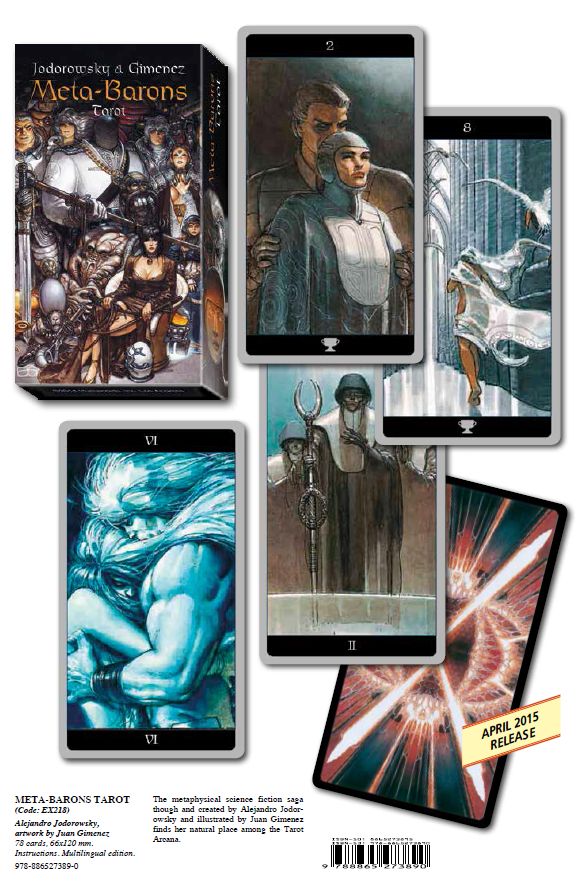
Chapters 5-10 constitute the "Gamemaster Section," and run about 70 pages. Despite the name, it contains the guts of the combat, movement, and space combat rules, so the players are going to read it anyway, but it's bookended by sections on gamemastering. However, the next section (chapters 11-13) is the "Adventure Section," which presumably the GMs aren't supposed to read either. So I'm saying, it's a wiggy layout.
Becoming A Gamemaster
Only the msot dedicated, battle-tested soldiers rise above the ranks to lead their peers. You've received your basic training in creating a character. Now I'll teach you how to run the Metabarons Roleplaying Game for your friends, with them playing the character's they've created, and you supervising the game as the gamemaster. Like a good commander, you'll be working with the troops (or your players, in this case) toward a common goal: telling an exciting interactive story, and having fun at the same time.

Normally, these intro-to-GM sections are rambling, philosophical affairs. Not Metabarons RPG! It breaks the GM's role down into three jobs (Judge, Storyteller, Scene Setter) and breaks those down into separate tasks, like keeping things moving, engaging all of the characters' senses, maintaining the illusion of free-will, etc. It's a weird mix of practicality and old-school gamemastering advice, when you boil it down. It's actually not bad for four pages - the weakest section(s) are the Recommended Reading, which basically keeps pointing the potential GM to different sections of the book, but never outside the book.
The Rules
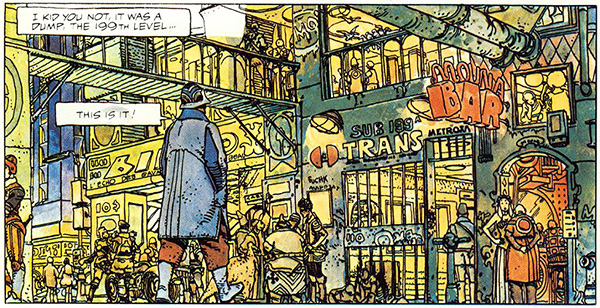
This section covers the basic mechanics. Which you would have thought we'd already covered, with skill rolls and shit. But you would be wrong!
tl;dr: one die in ever skill roll explodes if you roll a 6 on it. And if it rolls a 1 "the player must tell the gamemaster. This is bad."Whenever a character makes a skill or attribute die roll, the player must choose one die of a different color to be the character's wild die. This die is not an extra oe rolled, but one of the dice the character would normally roll for a skill. For instance, if Chris rolls the noble Lucardo's archaic weapons skill of 5D+2, he'd roll four dice of one color, and one die of a different color... his wild die.
...I'll be honest with you, the Wild Die is bullshit. It isn't necessary. Either all dice should explode, or none of them do.
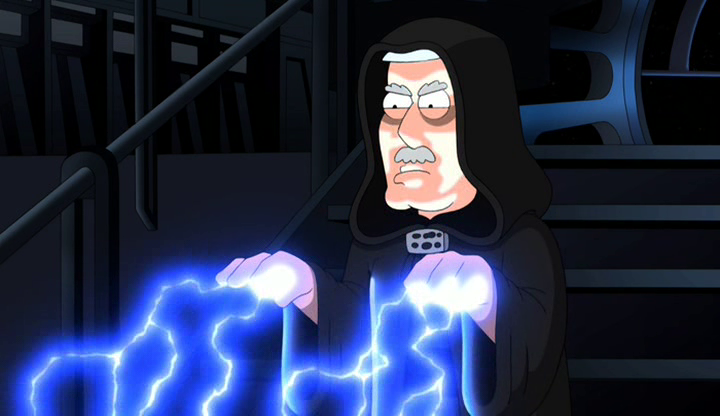
We get a re-hash on difficulty numbers and some notes about opposed roles - this is all shit that Shadowrun 4e stuck in the beginning of the book - some jive about the difference between scenes and rounds, which is pretty straight post-80s d6 style: roll initiative! (In this case, determined by your Perception attribute.) ...then take turns. The nice thing is, each side in combat acts at the same time, rather than rolling individually, but you still go in (Perception-declining) order. There's a lot of gamemaster notes here, so you can sort of tell why this is in the Gamemaster Section, but you'd think the players would need to know about initiative order but not need to know about GM-asspulls and secret skill checks. This chapterette ends with a page on Character Points which tells us nothing we hadn't already absorbed by reading through the Skills chapter.

Combat & Injuries
We're still in the GM Section, and we've already gone through initiative and combat rounds and shit, so I don't know why we need this chapterette, except someone remembered 80s and 90s games had them and felt it was necessary to talk about different combat options and their modifiers. I can't swear that the people writing this weren't reading a copy of Shadowrun 2nd edition when they were writing this, but I swear to Ghost this Grenade Deviation Diagram looks familiar, and there are some reeeeally familiar bits about Called Shots and Cover...but at a certain point in the 90s lots of games had basically begged and borrowed material from each other and converged at some common terminology. So there's stuff about Armor (which just adds to Strength for resisting damage), damaged armor, damaged weapons, scale (bigger things get big modifiers to their nominal Strength), surprise, an optional d6 hit location system...etc.
Damage is wound-based rather than track-based or hit point based; you roll to resist attacks and if you fail, you consult the chart to see how fucked you are. Overwhelming attacks can kill you outright, as can cumulative wounds.

Healing is a Strength-check, and you check whether or not you heal naturally after three days of rest, which is perhaps realistic but unhelpful in an RPG; if you screw up the roll your wound(s) can actually worsen. Fortunately, there's unnatural healing in the form of first aid, medkits, auto-medics, and medicines.
Movement & Chases
I'm not going through all this. It's not a grid-system like d20, and there are some...oddities. Damage from collisions, for example, depends on how fast the character was moving relative to their top speed - but the actual speed they were moving doesn't matter. A character with Move 4 moving "all out" 16 m/round and a character with a Move 10 moving "all out" at 40 m/round would both resist 4D damage if they collide with something. Vehicles follow much the same rules, just faster, with some added shenanigans for acceleration, deceleration, terrain, and maneuvers. Vehicle collisions are more painful (10D for a vehicle moving all-out, regardless of what all-out means in the context of the speed of the vehicle). Lots of rules on vehicle combat, weapons, ramming...
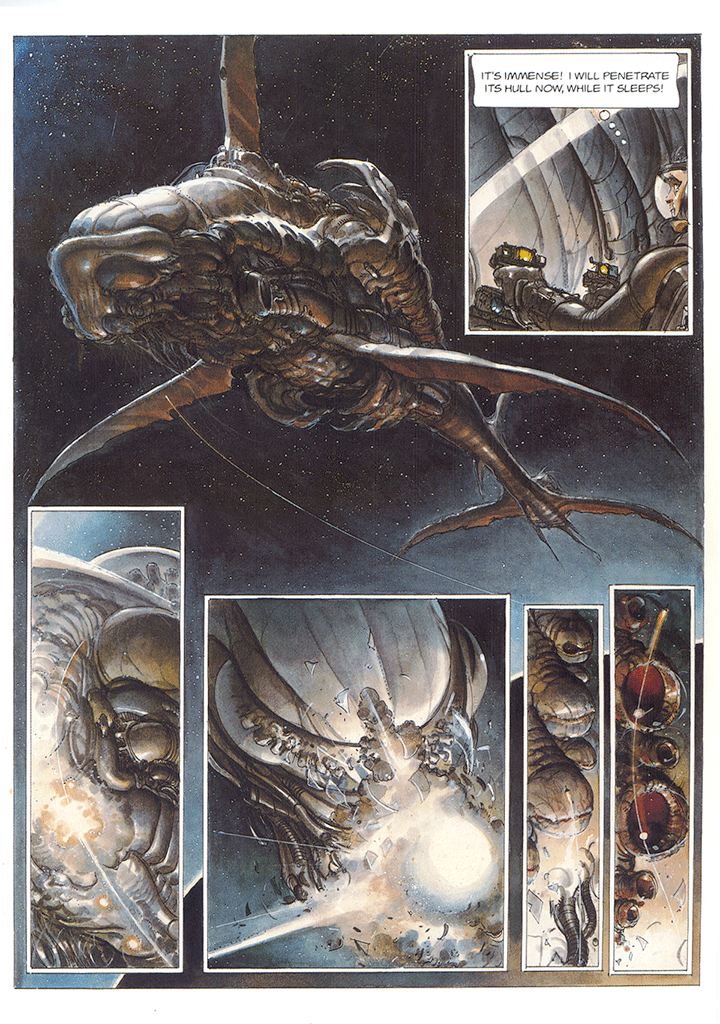
No word on riding animals or space whales, but that's an honest oversight.
There's a big page-and-a-half sidebar about running cinematic chases and how to handle three-dimensional combat, which involves pulling things out of your ass and careful measurements with sliderules, respectively.
Honestly, while this is a very robust set of vehicle movement/combat rules, it's a little intimidating to new players and you're basically pausing the game to sit a maths exam to do it. That had more appeal to me when I was 16 and calculus was about the limit of what was on my radar, but I don't know that I have the patience for it now.

Space Travel & Combat
Mostly involves getting a ship and flying it. Which I approve of, in a space opera game, but there's lots of technobabble for the Star Wars-level ships we're seeing, with talk of hyperspace shadows and hyper-lanes. This is basically for the one PC or NPC that invests in the Astro-Nav skill. I appreciate this as a level of detail you normally only get in Traveller and GURPS games - and GURPS didn't even go into this level of detail in Planet Krishna - but it's way robust for one-shot game on a d6 engine. Mainly I like this chapter for the full-page spaceship porn they sneak in.
Running Battles
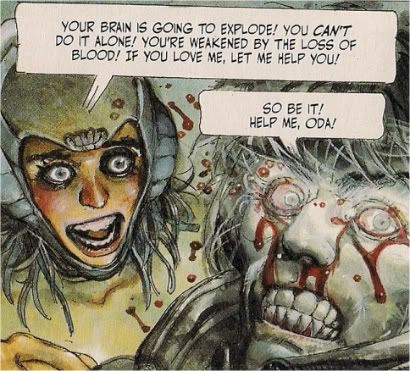
Paleo-Christ! Isn't this done yet?
Okay. So we've covered combat, then we covered combat again, then vehicle combat, then space vehicle combat, and now...this is supposed to be a system for running mass battles. Like, thousands of troops. It basically suggests breaking the character's part in the battle down to three or four critical encounters, with set-up and ending scenes, so that the PCs can affect the course of the battle without having to roll for every single space-pirate, and then gives an example of several different types of battles.
As advice goes, it's okay. It's more on the magic teaparty side of things than the minis set-piece battles kind of way of working things out, but it's not far from what I wrote about the Kowloon Massacre in Ghost Cartels. PCs need to feel involve, and they need to be involved, their actions should matter, and yet they are a only a few actors among many...picking out some critical encounters isn't a bad way to do it, even if it means your weekly gaming session for the next month or so is taken up playing out "The Battler of Endor the Forest Moon."

And that was the gamemaster section. Next up, the Adventure Section!
- Judging__Eagle
- Prince
- Posts: 4671
- Joined: Fri Mar 07, 2008 7:54 pm
- Location: Lake Ontario is in my backyard; Canada
Don't look up "Fando y Lis" then. Jodorowsky started making film with stuff so over the top that audiences would storm out in a riot, and countries would ban screenings. The fact that Jodorowsky intentionally filmed this strange and controversial film in black & white only makes the the content more stark and unsettling. I've watched "The Holy Mountain"; and I'll likely watch "El Topo".... but I don't think I'll actually want to watch "Fando y Lis" for pleasure.Shrieking Banshee wrote:I know Jodorowsky, I know dune. But I didn't think that Dunes crazy scale was on the BOTTOM edge of things he created.OgreBattle wrote:Here's a clip to one of Jodorowsky's films:Shrieking Banshee wrote:Sounds frikking Brutal.
Did Dethklock design this world? Regardless this feels allot more fun and self satirical then 40K.
https://www.youtube.com/watch?v=zPxqWTV ... SqO_dSVb3b.
Much of the over the top content in Jodorowsky's films has to do with the fact that Jodorowsky was: A) (very likely) really bored with most script ideas after finishing direction of ~100 screenplays & modern adaptations of classic screenplays; and B) Jodorowsky literally doesn't give a fuck about conventions or regulations. He started directing film without being a member of appropriate unions, and apparently broke said unions in doing so. He has scenes of animals being killed (this is pre-"Heaven’s Gate" (1980), when AHA presence in US made films became mandatory, and animals dying on film wasn't seen as cruel or abusive); scatological alchemy; and
Back to the review, and specifically Amarax.
Jodorowsky defines themselves as an "Atheist Mystic", and from the linked images, it's clear that he has also has interest in the esoteric, Eastern mysticism, spiritual energy, destiny, transformation/evolution of the self/soul; and the like. Which probably led to the development of Amarax and Necro-Dream in the Metabarons game. Which is nice, but while the Techno-Techno Necro-Dream appears in some form or an other in the Jodoverse; Amarax is... really not there as a concept that interweaves between all characters within the Jodoverse.
While the fact that the Techno-techno priest-cult is systematically poison-killing the galaxy is something someone who has read enough Jodorowsky might have learned (it's almost invisible in L'C d Metabarons (only the T-T's bloody invasion of a inhabited Imperial planet is the only really obvious sign of these tendencies), less immediately apparent (but constantly hinted at; until fully revealed in gruesome detail) in L'Incal; and the T-T's corruption to their core is the primary motivation for Albino in Technopriests to eventually "redeem" the Techno-technos by leading 500k young T-T's to a "new galaxy").
The notion of there being "good" points for people to collect is... honestly; feels like something tacked on as a game mechanic. While there are various ways characters have demonstrated development of new and higher moral, spiritual, or ethical plateaus within the Jodoverse; those are on a case-by-case basis, and there's no rubric or true similarity by which any of them could be measured.
Is San Nom going to earn Amarax for finding milk for an infant Solune at 4 in the morning the first time he's tasked as their guardian-father? How about for deciding to not kill a bunch of bystanders while he annihilates a pair of rival riot-columns off-panel?
One is a "positive" action (that is "constructive", and developmental/"new" for the character). While the other is the character deciding to punish obvious wrong-doers, and protect the innocent. They're also incredibly different sorts of narrative, and game, actions.
Is Luz going to earn Amarax because she brings her Pirate-Noble not(yet)-boyfriend to try and rescue a mind-wiped John DiFool who she still is in love with? or is John DiFool going to earn Amarax because he tries to apprehend the beautiful Techno-Techno acolyte who is trying to make out with him?
Both characters are "proactively" trying to "do right"; but the audience will likely feel that DiFool is the wrongdoer in this scene, but will acknowledge that they are a tragic figure due to previously agreeing to save his friends (Luz included), in exchange for being mindwiped.
Which is where I guess I'm going with this argument against Amarax. It's going to lead to bullshit situations where you earned Amarax for doing something self-sacrificing, heroic, and noble; but will then earn Necro-Dream when the prices you paid for such heroism forces you to make bad choices. Which is bullshit, you shouldn't be punished at the game mechanic level for subjectively "wrong" things that are the product of objectively "right" things. Especially if the source material; and even the rulebook itself; have totally opposing moral codes being presented as if they were legitimate and morally acceptable.
The Gaming Den; where Mathematics are rigorously applied to Mythology.
While everyone's Philosophy is not in accord, that doesn't mean we're not on board.
While everyone's Philosophy is not in accord, that doesn't mean we're not on board.
- Ancient History
- Serious Badass
- Posts: 12708
- Joined: Wed Aug 18, 2010 12:57 pm
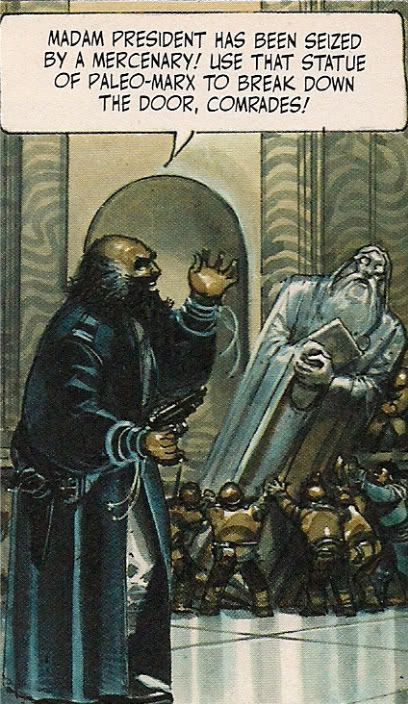
Not enough adventures involve comrades screaming about Paleo-Marx.
Adventure Section
Really an addendum to the gamemaster's section, the Adventurer's Section consists of three chapters: Running Adventures, Designing Adventures, and an adventure "The Maganat's Daughter."
I'm not particularly impressed with the "Running Adventures" section. It's a hodge-podge of suggestions, like using music to set the mood, keeping quick-reference cards for characters handy, toys (I suspect this was supposed to mean "miniatures," but it talks about spaceships and stuff, so this isn't clear), etc.
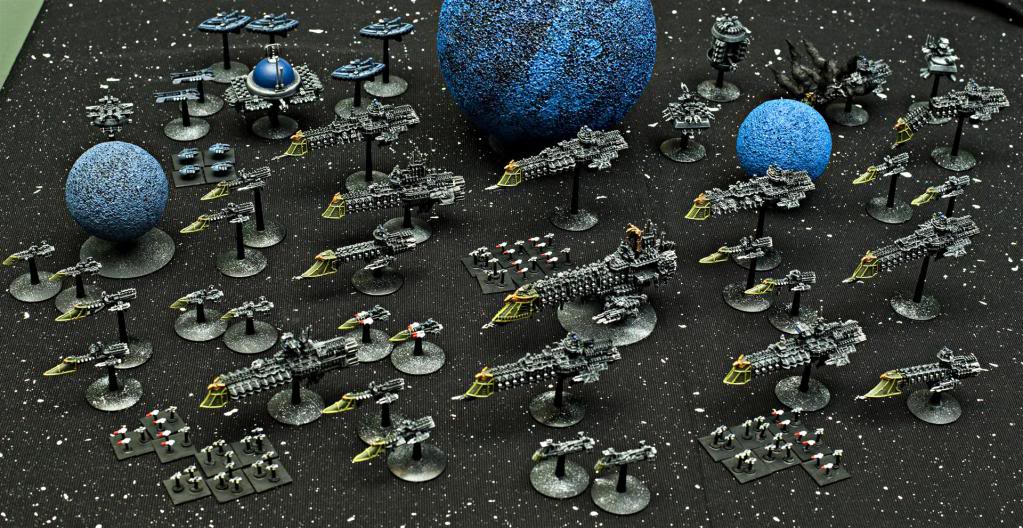
At last, our time has come.
One part about using the Metabarons comics is particularly half-assed:
...none of this is true. The Jodoverse are like operatic characters, written in bold colors and set in a blatantly space opera setting...and you can't play any of the Metabarons or other major characters. So while it might sound cool to be aspired by the Techno-Pope (whose abilities the game does not provide mechanics for) or a Space Pirate, or perhaps a ninja...If you're running a scene that includes elements form the comics--people, skirmishes, weapons, spaceships--you can pull out a comic, turn to the appropriate page, show it to your players, and say "The person you encounter looks just like this," or "Here's some idea what the battle looks like."
Letting players read through the comics before you begin a Metabarons Roleplaying Games is a good way to get them excited about the game: potential character types they might want to play, ideas of Honor Codes they might follow, and the overall atmosphere of the universe they'll explore through roleplaying.
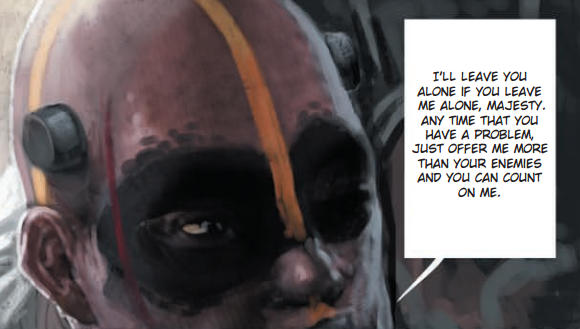
I couldn't find an image of the ninja.
The thing is, the Jodoverse isn't as deep or well-developed as the Dune 'verse it apes. I mean yes, there's lots of material there, and the PCs explicitly are going to want to explore that 'verse, but they are very explicitly not the movers-and-shakers of the universe. They're scruffy-looking nerf-herders out for a buck or an adventure or something. And the whole "who are you and why are you working together" schtick is a tricky one, and one...they don't address. Like D&D, they assume you're adventurers grouped together to go adventuring...and leave it at that.

Designing Adventures isn't much better; I would say it is competent without being particularly interesting. It's the type of thing that Robin Law would write out, via random twitches of his left hand, if he was in a coma after a bad motorcycle accident. It tries to give a procedural method for designing an adventure, starting with "Devise a good story idea." Well thanks for that, asshole. The only really good advice in this section is to steal borrow ideas from other peoples stories, and a sidebar on listening to your players.
Your players are your best source for story ideas. When playing, take mental notes of what sort of adventures and plots interest them. Note what goals they establish for their characters. Ask them if they want to fight any particular type of villain or visit a specific place. What you learn by taking these actions may spark a story idea--one with the added bonus of being of great interest to your players!

"The Maganat's Daughter" is a sample adventure. It's a pretty standard "businessman's daughter is missing, here are monies to find her" job (surprise: she's been kidnapped by space pirates. Double surprise: "kidnapped" - the space pirate captain is her lover!). As these things go, it's not bad. One part investigation with two parts dungeon-crawl, it's broken in to three sandbox episodes based on the expected curve of the adventure. There's also a one-page handout called an "adventure script" - literally, the PCs are handed this script to read to get started in the adventure. Definitely on the optional end of the spectrum.

The most exciting part of this overblown shabang is the "burrow-claw," which looks like a walrus with giant claws on its front limbs with the head of an alien spider. I don't know how else to describe it, so I'll let them do it:
The thing has 7D Strength and does Strength+1D damage, but only has 2D Agility and Perception. So it's a bit like a moose: it probably can't dodge or hit you, but if it does, it's going to rip you a new asshole.The burrow-claw is a subterranean mammal native to the vast grassy plains of Delft V. Its snout is black and covered with sensory buds which exude a gooey mucus. Several stalks extend from just behind the nose; each is about a meter long, and ends in a circular, toothy aw. It digs beneath the planet's surface using powerful forelegs with shovel-like digging paddles, with a longer, pointy claw on each side. The paddles dig into the soft ground and pull the creature forward, while two huge paddle-legs near the back push it through the packed-dirt tunnels it bores. Its bulky body is covered in hardened skin plates. The burrow-claw is normally a gentle creature that goes about its business digging for small animals to eat, water to drink, and nutrient to absorb from the soil. It's often attracted to investigate surface activity, although it is terribly uncoordinated and ungainly above ground.
There's not a whole lot else to say about the adventure. It's not confusing, it's pretty by-the-numbers, and there's no particular set of skills you need to get through it - although a little muscle or sneakiness would be good things, and the GM is supposed to handwave if you fuck up and steer the ship into the sun or something.
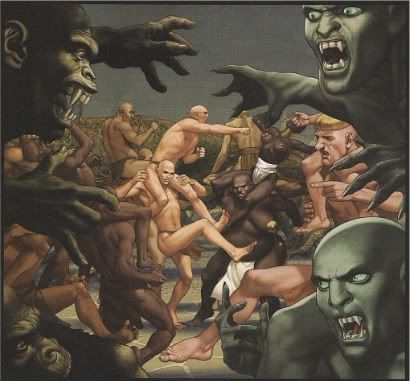
Anyway, next up is the section you've been waiting for - the one people probably bought the book for - the thing they should have led with: the Universe Section!
I waited to watch it until kids were away, then was like "Shit, the kids will love this! I guess I was overly worried, eh?" Then 2:15 onward happened. Hunh. Now I'm torn. Probably won't encourage them to enjoy that, if only to keep my house less messy.OgreBattle wrote: Here's a clip to one of Jodorowsky's films:
https://www.youtube.com/watch?v=zPxqWTV ... SqO_dSVb3b.
The six attributes are basically the same than in WEG Star Wars D6, except for Dexterity renamed Agility - with the same balancing issue.Plus, the skills are in no-wise balanced between the attributes - all the combat skills are under Agility, Strength has a grand total of four skills (Climb/jump, Lift, Stamina, and Swim), Psionics has three (Energy, Influence, Self-Control), and I don't understand the difference between Technical attribute skills and Mechanical attribute skills.
Mechanical and Technical were made distinct attributes for the sole purpose of making Luke Skywalker and Han Solo better pilots while Chewbacca and R2-D2 would be better at repairing the spaceship. This despite the fact that introducing skills to raise on top of attributes would address this just as at well (which make me things they established the attributes before having the idea to introduce skills).
An oddity of the D6 Systems is the Perception attribute, which covers regular perception, all social skills, but also initiative. Combat-type characters rather focus on Dexterity/Agility (to hit and dodge) and Strength (to resist and damage in close combat), you often see the bard/face archetype acting first. You can design your own template in order to max out Dex and Per, possibly along with Str, but you will suck at all other three attributes - which is not a problem as big as it may seem (except for playing a part onboard a spaceship).
Knowledge is usually the dumpstat because it is mostly what it says. What you're getting from it are piece of information about the universe the team eventually needs to move successfully forward. You're not doing anything: you roll dice and the gamemaster speaks for you to deliver information. The only skills that depart from this are Languages, Intimidation, Survival and Willpower. While it may fit well with a seasoned explorer archetype, most players often are disappointed not to be able to be a bad-ass fighter or pilot as well, and drop Knowledge instead (and do does adventurers' widespread lack of actual survival skill get to be a common trope of RPG).
And, in case you notice, yes, there is a modifier for the Intimidation skill that allow Strength-based characters to catch up on Knowledge-based characters.
Again, this is similar to WEG Star Wars, which had Force use divided into three attributes (Control, Sense and Alteration). However, Metabarons is nicer (SW pretty much required to have and roll two or all three attributes to get anything significant effect).Psionics are divided into three skills: Energy, Influence, and Self-Control, which characters roll for a wide variety of effects. In keeping with the idea that you shouldn't have nice things, the target number for any given effect is variable like you're building a spell in Shadowrun, except without all the nice details that make it easy to determine what you need to roll to set shit on fire - instead, you're basically expected as Gamemaster to pull numbers out of your ass, with a few guidelines to help you along your way.
Energy represents the character's ability to sense and manipulate energy - the three effects tied to it are "Detect Energy," "Mental Blast," and "Shield", which are pretty self-explanatory.
Influence is explicitly the Jedi mind trick. 'nuff said.
Self-Control is pain-control and physical enhancement. The latter gives you bonuses to your other attributes, which also boosts the associated skills...not a bad way to go.
Again, those replace WEG Star Wars Force points and Dark Side points. Turning into a NPC also was the result of getting too much Dark Side points (save using an optional rules introduced in the second edition). However, Metabarons takes a somewhat relativist stance with various codes of honor, instead of an inescapable, universal Jedi code.I have briefly touched on the Code of Honor and Amarax points. The latter are something created basically uniquely for the RPG. The gist is, the Code of Honor is how you're supposed to behave. Amarax Points are like Action Points in D&D3.x or Willpower in WoD, which you can spend to boost various tests - with the caveat that you only regain the Amarax points if you spent them doing things in accordance with your Honor Code (in which case you get more!)
[...] If you end an adventure with no Amarax points, or more Necro-Dream Points than Amarax points, your PC becomes an NPC. Characters can also roll willpower to resist the temptations of the Necro-Dream (examples given include "taking a drink of Cocolo; spending the night with a homeoslut; participating in holovid gambling; sitting down to watch holovid for the aternoon.") You can also spend two Amarax poins to remove one Necro-Dream point, which sounds like a bad deal and it is a bad deal.
As far as I remember, all of those where in WEG Star Wars first edition in 1987 (the grenade scatter, I'm pretty sure).I can't swear that the people writing this weren't reading a copy of Shadowrun 2nd edition when they were writing this, but I swear to Ghost this Grenade Deviation Diagram looks familiar, and there are some reeeeally familiar bits about Called Shots and Cover...but at a certain point in the 90s lots of games had basically begged and borrowed material from each other and converged at some common terminology.
- Ancient History
- Serious Badass
- Posts: 12708
- Joined: Wed Aug 18, 2010 12:57 pm
- Ancient History
- Serious Badass
- Posts: 12708
- Joined: Wed Aug 18, 2010 12:57 pm

Universe Section
The Jodoverse is based, as I've mentioned on Dune. Jodowrosky wisely used Frank Herbert's setting, with its diverse but distinct factions, as a jumping-off and reference point rather than as an end-goal. The authors of this book, not so much. So the Imperium is replaced by the Human Empire; the Saudakar by the Endoguard; CHOAM by StellComm; the Landsraad by the Maganats; the Bene Gesserit by the Shabda-Oud.
To this basic framework Jodowrosky grafted some more typically European/South American elements - the Techno-Pontificate (i.e. the Technopope and Techno-Priests, known as the Techno-Technos) combines elements of the Vatican and the Bene Tleilaxu. The Ekonomat is the imperial bank, the Union of Planets a primitive parliamentary system of member-worlds, and the Troglosocialiks...
The paleo-Marxist nature lover Troglosocialiks are just one example of the culturally fringe groups finding refuge among the new worlds in the domain of the Colonial Planets. They attract a steady stream of disaffected citizens who believe the universal possession doctrines of Marxism and the ideals of ecological preservation hold the key to happiness and prosperity.
With these goals in mind, the Troglosocialiks find pristine worlds to colonize, maintaining the planet's natural state wherever possible, keeping vast natural preserves in public trust for all to enjoy--much like property throughout the urban areas. They're one of the more fanatical political causes tolerated by the Human Empire.
Like any government, individual Troglosocialik enclaves are easily corrupted into new forms best serving those in power. Most play on the fundamentals of Marxism and ecology to manipulate the populace.

Paleo-Marx is back - with vengeance!
All of this is presented...a bit broad-strokes. I mean, there are paragraphs on pirates, mercenaries, terrorists, aliens, and mutants, but the whole thing is like trying to boil down the factions of Dune without describing in any detail how the various powers or factions interact; the strengths and weaknesses of the various parties are entirely a matter of narrative necessity.
There's a section on the technology, which is where the Jodoverse really goes away from Dune - because Frank Herbert wanted a universe without computers - and is much closer to Star Wars in having a variety of spacecraft (including battleships designed for combat), anti-gravity craft, faster-than-light travel and communications, robots, etc.

Robochrist wouldn't show up until many years later, in Jodowrosky's Screaming Planet.
The description of the Universe is ultimately extraordinarily superficial and unsatisfying. It doesn't really build on Jodowrosky; it doesn't even cover the general complexity of one volume in his series, and aside from a couple specific highlights like the Troglosocialiks it's so generic and paint-by-numbers it's painful. I find myself wishing the GURPS folks had a go at this.
Also included in this section is a chapterette on building NPCs ("gamemaster characters"), which includes abbreviate stats for a number of typical NPCs. This is followed by a "Creatures" section which is a bog-standard bestiary, with creatures like the Frazzhornet, Glossglok, Kamamba, Xarmadillo, and Eodactyl.

I said eodactyl.
Don't think you're going to get a full twenty-thirty pages of weird alien critters; it's quite literally three pages and eight critters, only some of which actually appeared in the books.
Then we get "Weapons & Technology" - this is the equipment section. I had to go back to the character generation section, and despite the fact that all the equipment has costs attached, it's totally magic tea party as to what equipment you get - you don't get "Starting cash" to buy shit with, you're supposed to just pick out a reasonable selection of equipment, then get down on your knees and do whatever the GM wants you to do to get them to sign off on it. I can't imagine but that in practice most GMs would just give you a thousand kublars or something and tell you to go buy shit from the equipment section.
Costs...there's no real guideline for costs. The cost of a sword is quite literally given as "1 to 1,000 kublars." The same cost is given for bows. By contrast, a Gauss Rifle costs 750 kublars, and various and sundry pistols are 300 kublars. I understand that the "rule of cool" was in play and they wanted a wide variety of exotic energy weapons and stuff to reflect the arsenal in the Metabarons & related comics, but balance and costs aren't really taken into any kind of consideration. Armor and cybernetics in particular are ludicrously expensive compared to pretty much anything else; you can buy a couple of robots for less than the cost of a cybernetic arm, which I don't understand. If someone told me most of this stuff was ported over directly from Star Wars, with someone crossing out "credits" and writing "kublars," I'd believe it.
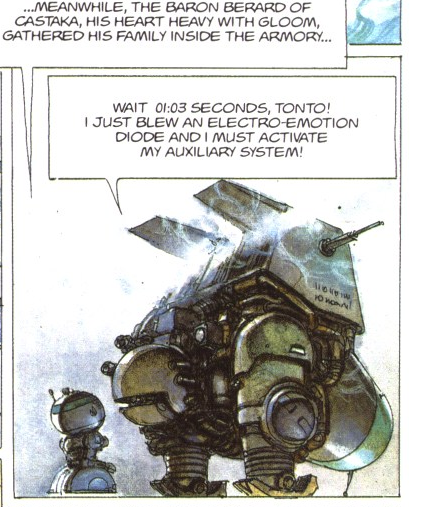
Honestly, if you make them all talk like this, it's a better investment.
There's a chapterette on vehicles. Mix of flying cars, exoskeletons, trankar (somewhere between a tank and light troop transport), etc. No prices given, because for fuck's sake, they already priced all the equipment in the last chapter, what more do you want? You want prices for everything? Fuck you! You're not going to buy any of this shit! You're going to steal it, or declare that you start the game with it, or something.
Same goes for the next chapterette, which is on spacecraft. Some of these look suspiciously like re-purposed X-wings and shit.

The final chapter in the Universe Section deals with Worlds, outlining various important - hah! You think they're actually going to go into all the important planets in the Jodoverse? Fuck you! These are templates and design suggestions for building your own planets, followed by a selection of Sample Planets. The only ones I recognize as coming directly from the comics are Baggdathi and the Golden Planet, which is the seat of government of the Human Empire. (Favorite line of the write-up: "The hotels and restaurants are all top-line.")
I'd bitch about this more, but the Jodoverse was never as centered around specific planets as Dune was. Still, after such a long trudge through the rules systems, it feels like they could have spent more time and wordcount on fleshing out the actual universe. I mean, it's granted that maps are really difficult things for space opera games, because all distance is narrative distance - you don't care if the next planet is a million kilometers away or a million lightyears away. When you watch Star Wars you have an impression of Tatooine as a place, but no appreciation for its relation with, say, Yavin IV.
The thing is, space travel is a fundamentally different concept of distance than any other mode of transportation. It's part of the wonder of space - because it is so vast, and it holds so many possibilities, and the distances are quite literally inconceivable to most, but also because everything is constantly moving - the usual frames of reference don't apply. In a typical sandbox game, there is always an edge to the map. You could walk to nearly any point on the surface of the Earth, given sufficient time (and possibly one of the bubble-walkers for the ocean), but in space it's points-of-light by default. Distances are so tremendous, and transportation so without context that all travel times are effectively just a narrative invention anyway.

Also, God in the Jodoverse kinda looks like Alan Moore.
That's basically it for the book. I mean, the Character Templates are in the back of the book, though I have no fucking idea why, since they'd be much more useful near the character generation section. There's a couple pages of reference tables for equipment you're not going to buy, and the index and a blank character sheet and...that's the book.
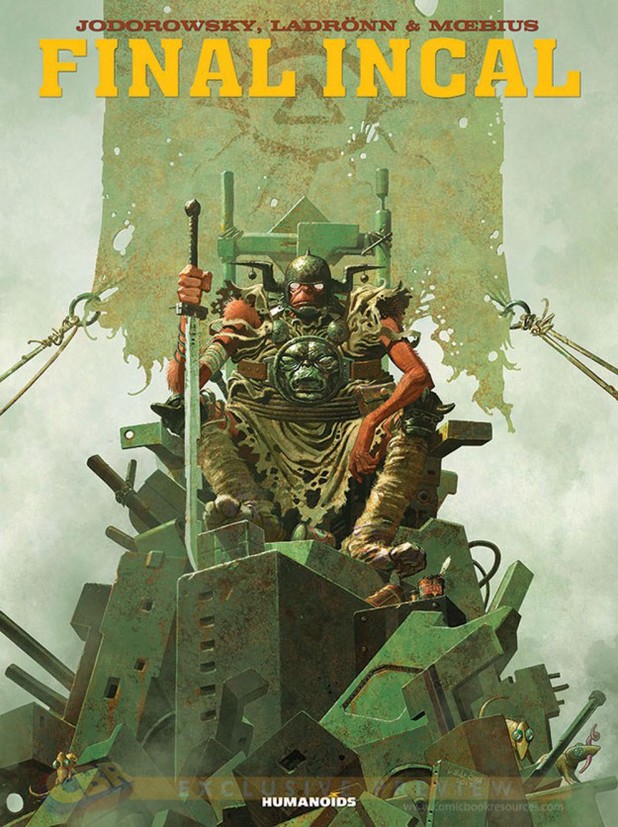
It's a beautiful book. But it's a bit vapid. NMath pointed out that the d6 system veers even closer to the old Star Wars d6 game than I had recalled, but even given that, there's just little there there. Most of the book is taken up with lots of beautiful art and gamemastering advice and the blatant assumption that you've read all of Jodowrosky's comics and are willing and able to mindcaulk the rest. There just isn't a distillation of his setting material, or any sort of strong narrative idea of why you as a group of player characters are going to get together and...do stuff.
Which is a relatively common problem with a lot of RPGs, not just licensed ones. With any setting, to some extant the player characters need narrative niches to fill, and to some extant players have to bring their own ideas and motivations to the table. It is okay for you to be a stalwart band of rebels which happens to include a wide-eyed farmgirl from a backwoods planet and a grizzled space mercenary only in it for the money; they can share a common cause while having distinct motivations. But you have to establish those causes and provide at least some sample motivations. I know we harp on this a lot, but that's because it's important.
In D&D, you're adventurers on an adventure - you may seek power, wealth, justice, excitement, political change, etc., but to do that you're adventuring. Similarly, in Shadowrun you're shadowrunners who go on shadowruns. The amoral mercenary criminal aspect is more than a little implied, since you're explicitly being paid, but it leaves room for other motivations. And in both cases, beyond being an adventurer or a shadowrunner, it has narrative niches to fill - sorcerer, decker, fighter, street samurai, monk, physical adept, bard, detective - not necessarily roles as such, since those are largely defined by the system (pornomancer, healer, tank, lancer, face, etc.), but conceptual divisions that players can grok quickly and use to cast their own characters.
The Metabarons RPG...doesn't quite have that. They have the templates, this is true, but the universe material is too scanty to really support the various templates or encourage their use. What is an S-class detective? Why would you play one? What is their purpose? The book has no answers for these questions, and that's pretty much why it fails.

I will leave you with this image from Jodowrosky's film The Holy Mountain, to contemplate.
Well, I can't imagine I'd ever play this game (might as well just use my old SWd6 books if I wished to) but thank's for introducing me to Jorodowsky. Finished Incal and half-way through Metabarons. Wonderfully wierd shit
The internet gave a voice to the world thus gave definitive proof that the world is mostly full of idiots.
As far as I understand, it was originally expected the GM would photocoy the templates and hand them to the players for character creations, or even to use as a character sheet in the first game sessions. And pages at the end of the book would be detached to ease the photocopy. Assuming of course they wouldn't fall by themselves, since that idea dates back to good ol' unreliable binding that was common in the 20th century.I mean, the Character Templates are in the back of the book, though I have no fucking idea why, since they'd be much more useful near the character generation section.
Now, for a bit of general context and how the game came into existence - RPG and comics audience, especially sci-fi comics, heavily overlap. French comics production was in a low mood during the nineties, so the release of La Caste des Métabarons really stood out, being sci-fi, well-written, beautiful and fun at the same time. It quickly became influential among individual gamemasters, as well as writers and illustrators involved in French RPG magazines, who would introduce elements taken from or inspired by it to use with Star Wars D6 (which I think was in the Top 5 games in France at the time).
- Ancient History
- Serious Badass
- Posts: 12708
- Joined: Wed Aug 18, 2010 12:57 pm
The binding on my copy is coming apart. I'm curious how much market penetration this game had in Europe, however - I mean, it's a mid-Atlantic production, split between Spain and les États-Unis, but done in English - pretty much because Humanoids owned WEG at this point. Did they do non-English language versions of this game?
It possibly was printed in Spain, but three authors - Julien Blondel, Marc Prudhomme and Fred Le Berre - are French (the others being I think USer), as is Yeti Entertainment S.A.
From what I can find on the Internet, the French edition had four extension books released in 2001: Univers (288 pages, about the Human Empire at large), Les Manganats (128 pages, the nobility, some planetary systems and three adventures), Les Codes d'Honneur (144 pages, codes of honor, Amarax and psionic rules, and two adventures) and L'Economat (128 pages, the Ekonomat organization and three adventures). One sourcebook, Les Coloniaux was cancelled when Yéti Entertainment shut down.
The fact Yéti closed its door its kinda telling about whether La caste des métabarons was successful or not in France. Though I can't back it with any numbers, I think it never went anywhere close in popularity to French sci-fi games Polaris (published by Halloween Concept between 1997 and 1999, along with the also moderately successful D&D expy Prophecy, and it still did not prevent the company from shutting down in 2002) or C.O.P.S. (published by Asmodée Editions between 2003 and 2006, probably the biggest French RPG hit in the 2000s, still didn't convince Asmodée to stay in the RPG industry).
From what I can find on the Internet, the French edition had four extension books released in 2001: Univers (288 pages, about the Human Empire at large), Les Manganats (128 pages, the nobility, some planetary systems and three adventures), Les Codes d'Honneur (144 pages, codes of honor, Amarax and psionic rules, and two adventures) and L'Economat (128 pages, the Ekonomat organization and three adventures). One sourcebook, Les Coloniaux was cancelled when Yéti Entertainment shut down.
The fact Yéti closed its door its kinda telling about whether La caste des métabarons was successful or not in France. Though I can't back it with any numbers, I think it never went anywhere close in popularity to French sci-fi games Polaris (published by Halloween Concept between 1997 and 1999, along with the also moderately successful D&D expy Prophecy, and it still did not prevent the company from shutting down in 2002) or C.O.P.S. (published by Asmodée Editions between 2003 and 2006, probably the biggest French RPG hit in the 2000s, still didn't convince Asmodée to stay in the RPG industry).
- Ancient History
- Serious Badass
- Posts: 12708
- Joined: Wed Aug 18, 2010 12:57 pm
... It's really a strange idea to adapt the Metabaron into a RPG.
I mean, there are several series of comics taking place in the same universe - l'Incal and the Metabaron being the most renowned, at least in France. And in all those series, the Metabaron is the least fitted for an adaptation.
The Metabaron is the story of a bunch of penis-enlarger DMPC who can do whatever they want. You can tell stories about those guys, but it's really hard to make those stories collaborative, since they're so powerful they can simply decide what happen next. They are all loners, so there's no "group dynamic". Their main goal is to find True Love to perpetuate their cast, this is not the kind of story that work very well in RPG.
In the other hand, l'Incal is the story of a random guy involved in an overwhelming adventure, who save the universe in the end. That's exactly the kind of story you want to tell in a RPG ; just replace the random guy with a group and you're done.
I mean, there are several series of comics taking place in the same universe - l'Incal and the Metabaron being the most renowned, at least in France. And in all those series, the Metabaron is the least fitted for an adaptation.
The Metabaron is the story of a bunch of penis-enlarger DMPC who can do whatever they want. You can tell stories about those guys, but it's really hard to make those stories collaborative, since they're so powerful they can simply decide what happen next. They are all loners, so there's no "group dynamic". Their main goal is to find True Love to perpetuate their cast, this is not the kind of story that work very well in RPG.
In the other hand, l'Incal is the story of a random guy involved in an overwhelming adventure, who save the universe in the end. That's exactly the kind of story you want to tell in a RPG ; just replace the random guy with a group and you're done.
Last edited by GâtFromKI on Mon Mar 21, 2016 2:30 pm, edited 2 times in total.
In the Incal the random guy already works often as part of a group. I would argue that even the sentient neonseagull pet counts as a PC, since it can talk and often gets shit done on its own. Heck, it can even pilot a gunship alone later on.GâtFromKI wrote:
In the other hand, l'Incal is the story of a random guy involved in an overwhelming adventure, who save the universe in the end. That's exactly the kind of story you want to tell in a RPG ; just replace the random guy with a group and you're done.
FrankTrollman wrote: Actually, our blood banking system is set up exactly the way you'd want it to be if you were a secret vampire conspiracy.
- Judging__Eagle
- Prince
- Posts: 4671
- Joined: Fri Mar 07, 2008 7:54 pm
- Location: Lake Ontario is in my backyard; Canada
L'Incal would absolutely make a better template for Jodoverse narratives to use for a game. The characters are fairly mortal; operate in groups of various sizes, and demonstrate that they can progress to take on more and larger challenges.
Party members could include:
-Grade-R Detective [Street Rat]
-Concrete Seagull [Sapient]
-Rogue Eyecop [Freed Eye]
-Independent Cybocop [Criminal: Theolgical ]
-Aristo Noblewoman [Chameleonized: Uglified]
-Aristo Prince [Covert Pirate, Hidden Mutant]
-Guardian of White Incal
-Giant Psychic Kangaroo-rat
-Androgynous Messiah
Temporary/Additional members:
-Sane Hunchback Cyborg
-Mutant Spiritual Leader
-The Metabaron
-Selfish Criminal Acquaintances
-Anarchist Suicide-bomber team
Potential Encounters/Enemies:
-Mutant quarter thugs/mercenaries
-Presidential Hunchback Cyborgs
-Riot-Column of Marchers
-Lesbian Gangers
-Street toughs
-Cybocops
-Eyecops
-Red Ring Bouncers
-Techno-Techno Pope
-Guardian of the Black Incal
-Wastelands Cannibal Mutants
For a slightly more powerful scale of character; the various characters in The Technopriests are slightly more than human; but aren't planet/universe breaking sort of power like a Metabaron, Zombra the Infinite, or a Cetacyborg.
The characters are pretty typical space opera fare, and are distinguishable from L'Incal's characters by having higher attributes; with the rare species-derived power (like extra arms; or retractable scrotum/testes). With Albino being a major exception. Gaining ever increasing ghost/mind powers. As well as defeating the ever more powerful commanders of the Techno-Techno's ghost & zombie-cult as they themselves rising through its ranks.
Party members could include:
-Grade-R Detective [Street Rat]
-Concrete Seagull [Sapient]
-Rogue Eyecop [Freed Eye]
-Independent Cybocop [Criminal: Theolgical ]
-Aristo Noblewoman [Chameleonized: Uglified]
-Aristo Prince [Covert Pirate, Hidden Mutant]
-Guardian of White Incal
-Giant Psychic Kangaroo-rat
-Androgynous Messiah
Temporary/Additional members:
-Sane Hunchback Cyborg
-Mutant Spiritual Leader
-The Metabaron
-Selfish Criminal Acquaintances
-Anarchist Suicide-bomber team
Potential Encounters/Enemies:
-Mutant quarter thugs/mercenaries
-Presidential Hunchback Cyborgs
-Riot-Column of Marchers
-Lesbian Gangers
-Street toughs
-Cybocops
-Eyecops
-Red Ring Bouncers
-Techno-Techno Pope
-Guardian of the Black Incal
-Wastelands Cannibal Mutants
For a slightly more powerful scale of character; the various characters in The Technopriests are slightly more than human; but aren't planet/universe breaking sort of power like a Metabaron, Zombra the Infinite, or a Cetacyborg.
The characters are pretty typical space opera fare, and are distinguishable from L'Incal's characters by having higher attributes; with the rare species-derived power (like extra arms; or retractable scrotum/testes). With Albino being a major exception. Gaining ever increasing ghost/mind powers. As well as defeating the ever more powerful commanders of the Techno-Techno's ghost & zombie-cult as they themselves rising through its ranks.
Last edited by Judging__Eagle on Wed Mar 23, 2016 9:50 pm, edited 1 time in total.
The Gaming Den; where Mathematics are rigorously applied to Mythology.
While everyone's Philosophy is not in accord, that doesn't mean we're not on board.
While everyone's Philosophy is not in accord, that doesn't mean we're not on board.